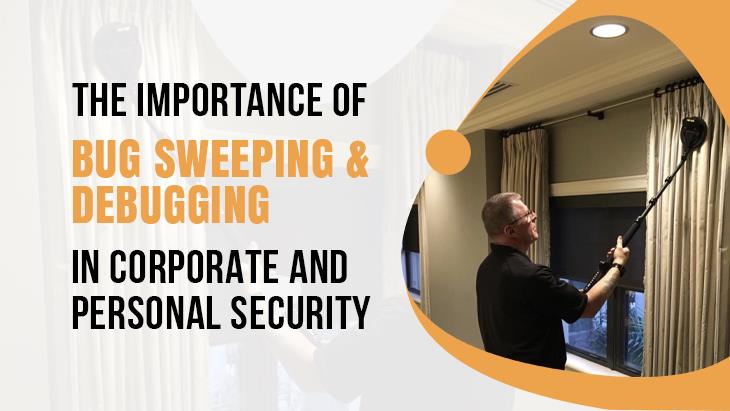In an era of hybrid work, insider risk, IoT devices, and always connectivity, confidential conversations and private spaces are easier to compromise than ever. Professional bug sweeping (Technical Surveillance Counter‑Measures, or TSCM) and de-bugging protect sensitive information, prevent reputation damage, and restore peace of mind—at work, at home, and in transit.
Bug sweeping and de‑bugging are not “nice‑to‑have” extras—they’re a critical layer in modern security. Pro teams identify and remove covert audio/video transmitters, hidden cameras, GPS trackers, and digital eavesdropping risks across rooms, vehicles, and networks, then harden your environment so threats don’t return.
What is bug sweeping and de‑bugging (TSCM)?
- Bug sweeping: A systematic search using specialized tools and trained techniques to detect covert surveillance devices (audio transmitters, hidden cameras, trackers) and indicators of digital eavesdropping.
- De‑bugging: Safe removal, isolation, and remediation—plus hardening to prevent recurrence.
- TSCM: The professional discipline that covers both, including reporting, evidence handling, and recommendations.
Why it matters for companies
- Protect confidential info: M&A talks, product roadmaps, IP, board strategy, legal matters.
- Reduce insider risk: Departing staff, contractors, and visitors can introduce devices or software.
- Comply and defend: Demonstrate reasonable security measures; preserve evidence if required.
- Safeguard reputation and valuation: A single leak can impact market position and trust.
Hire the Best Detective Agency in Mumbai for Home & Office Debugging
Why it matters for individuals and families
- Privacy in homes, rentals, Airbnbs, and hotels
- High‑profile and high‑net‑worth risk (public figures, executives)
- Stalking and domestic abuse protection (in coordination with law enforcement)
- Peace of mind during life transitions (breakups, legal disputes, moves)
Common threat scenarios
- Hidden cameras in rentals, offices, dressing rooms, or short‑term stays
- Audio transmitters planted in meeting rooms, desks, lamps, or vehicles
- GPS trackers on cars (magnetic undercarriage, OBD‑II, or hidden in cargo)
- Compromised conference phones, VoIP endpoints, or softphone laptops
- Rogue Wi‑Fi access points, insecure IoT plugs, smart speakers/cameras
- Mobile device spyware and malicious configuration profiles
Signs you may need a sweep
- Unexplained leaks or “too‑accurate” rumors about private discussions
- New or out‑of‑place devices, wall plates, cables, or power adapters
- Interference or anomalies on conference calls or RF meters
- Unexpected batteries, SD cards, or SIMs found on premises
- Sudden spikes in data use on office/home networks or vehicles
- Changes after terminations, renovations, moves, or break‑ins
What a professional sweep includes
A credible TSCM sweep blends physical, electronic, and digital analysis. Expect:
- Site risk assessment: Floor plans, threat modeling, high‑value targets (boardrooms, offices, bedrooms, bathrooms, vehicles, shared walls).
- Physical search: Systematic inspection of furnishings, fixtures, ceilings, vents, outlets, lamps, artwork, and common concealment sites.
- RF spectrum analysis: Scans for active transmitters across relevant frequency ranges; demod checks for audio/video payloads.
- Non‑linear junction detection (NLJD): Locates hidden electronics (even if powered off) in walls, furniture, or objects.
- Optical/IR checks: Lens detection for pinhole cameras; IR/visible light sweeps in low‑light conditions.
- Thermal and power analysis: Identifies heat signatures and suspicious loads on mains or PoE circuits.
- Wiring and cable tracing: Inspects telephony, Ethernet, HDMI, and patch panels for taps or rogue devices.
- Network and Wi‑Fi survey: Maps SSIDs, identifies rogue APs, scans for default/weak credentials, and odd traffic patterns.
- Vehicle sweeps: Undercarriage, OBD‑II, cabin, and cargo checks; RF and physical inspection.
- Mobile/endpoint triage: Policy‑compliant triage for spyware indicators; referrals for full forensic analysis when appropriate.
- Documentation and chain‑of‑custody: Photographs, device handling, time‑stamped logs; evidence preserved if needed.
- Remediation and hardening: Safe removal/neutralization, network hardening, and policy updates.
Digital risks: phones, Wi‑Fi, and IoT
- Smartphones: Commercial spyware and malicious profiles exist. Professional mobile forensics can assess risk; keep OS updated, use MDM where appropriate, and enable hardware‑level security features.
- Wi‑Fi/Networks: Use strong authentication (WPA3/802.1X where possible), segment IoT, disable UPnP, and audit guest networks. Monitor for rogue APs and unusual outbound traffic.
- IoT and smart speakers: Treat voice assistants and cloud cameras as “always‑on microphones.” Use meeting‑room protocols (device‑free sessions or certified storage) for sensitive discussions.
Legal and ethical considerations
- Laws differ: Consent for recordings and counter‑surveillance actions varies by jurisdiction.
- Don’t jam: RF jammers are illegal in many countries.
- Evidence handling: If you find a device, improper handling can jeopardize a case. Engage professionals to preserve evidence and coordinate with counsel and law enforcement.
- Workplace policy: Clearly communicate privacy policies and acceptable‑use; coordinate with HR and Legal.
How often should you sweep?
Corporate
- High‑risk areas (boardrooms, executive suites, R&D labs): Quarterly or around sensitive events (M&A, earnings prep, major product milestones).
- General offices: Semi‑annually to annually, plus after renovations or staffing changes.
- Travel/off‑site events: Pre‑event checks; day‑of room validation.
Personal
- New residences, rentals, or after a move/renovation: On occupancy.
- After relationship changes, legal disputes, or suspected stalking: As soon as safely possible (with law enforcement guidance).
- Vehicles: After service by unfamiliar providers or suspicious patterns.
What to do if you suspect surveillance
Do
- Move to a different, trusted location before discussing suspicions.
- Limit nonessential electronics use; save unusual devices for professionals to examine—don’t power them repeatedly.
- Document observations (photos, times) without tampering.
- Contact a qualified TSCM provider and, where appropriate, law enforcement.
Don’t
- Confront potential suspects.
- Publicly announce a sweep.
- Use illegal signal jammers.
- Destroy or discard suspicious devices—this can harm investigations.
How to choose a provider
- Qualifications: Look for specialized TSCM training/certifications and relevant security credentials (e.g., ASIS CPP/PSP). Ask about ongoing training and lab capability.
- Independence: Avoid conflicts of interest (e.g., same firm selling consumer “spy gadgets”). Insist on vendor neutrality.
- Equipment and methods: Modern, calibrated tools; coverage of RF, NLJD, optical, thermal, wiring, network, and vehicles.
- Reporting: Chain‑of‑custody, photos, device inventories, and clear remediation guidance.
- References and discretion: Experience with board‑level work and high‑profile clients; strong confidentiality posture and NDAs.
- Scope and pricing clarity: Defined areas, duration, on‑site disruption plan, and follow‑up support.
Myths vs reality
- Myth: “No one targets us.” Reality: Opportunistic threats are common, and insider risk crosses every industry and household.
- Myth: “A cheap handheld detector is enough.” Reality: Many devices are burst/packet‑based or dormant; layered methods are required.
- Myth: “Sweeps mean we don’t need policies.” Reality: Sweeps are one layer; combine with access control, device‑free meetings, NDAs, and security awareness.
- Myth: “Turning off Wi‑Fi stops everything.” Reality: Devices can store locally, use cellular, or piggyback on other power/data lines.
FAQs
Q: Will a sweep disrupt operations?
A: Professional teams plan around your schedule. Expect some short room closures and controlled device power‑downs during testing.
Q: Can you find powered‑off devices?
A: Some tools (e.g., non‑linear junction detection) can locate electronics even when they’re not transmitting. Physical inspection remains essential.
Q: Do sweeps also cover phone spyware?
A: Teams can triage for indicators and coordinate full mobile forensics if needed. Expect separate consent and handling protocols.
Q: Are consumer detectors worth it?
A: They can flag obvious risks but miss dormant, wired, or packet‑burst devices. Use them as a stopgap—not a substitute for a professional sweep.
Q: What deliverables should we expect?
A: A confidential report with findings, photos, remediation steps, and chain‑of‑custody documentation. Some providers also offer policy and training recommendations.
Q: How much does a sweep cost?
A: Pricing depends on size, complexity, travel, and scope (rooms, vehicles, networks). Reputable firms provide a clear, scoped quote up front.
Conclusion
Confidential information is the backbone of trust—whether in business or personal life. Ignoring the risk of covert surveillance can open doors to data theft, blackmail, and reputation loss. Regular bug sweeping and de-bugging are no longer optional—they are essential defenses in today’s digital-first world.
If you suspect hidden devices, unexplained leaks, or simply want to ensure a secure environment, don’t take chances. Spy Detective Agency, a leading name in TSCM and debugging services in Delhi, India, offers discreet, evidence-driven inspections for offices, vehicles, and private residences.
🔒 Protect your privacy before it’s compromised.
Contact Spy Detective Agency today for a 100% confidential consultation and professional bug sweeping service you can trust.


